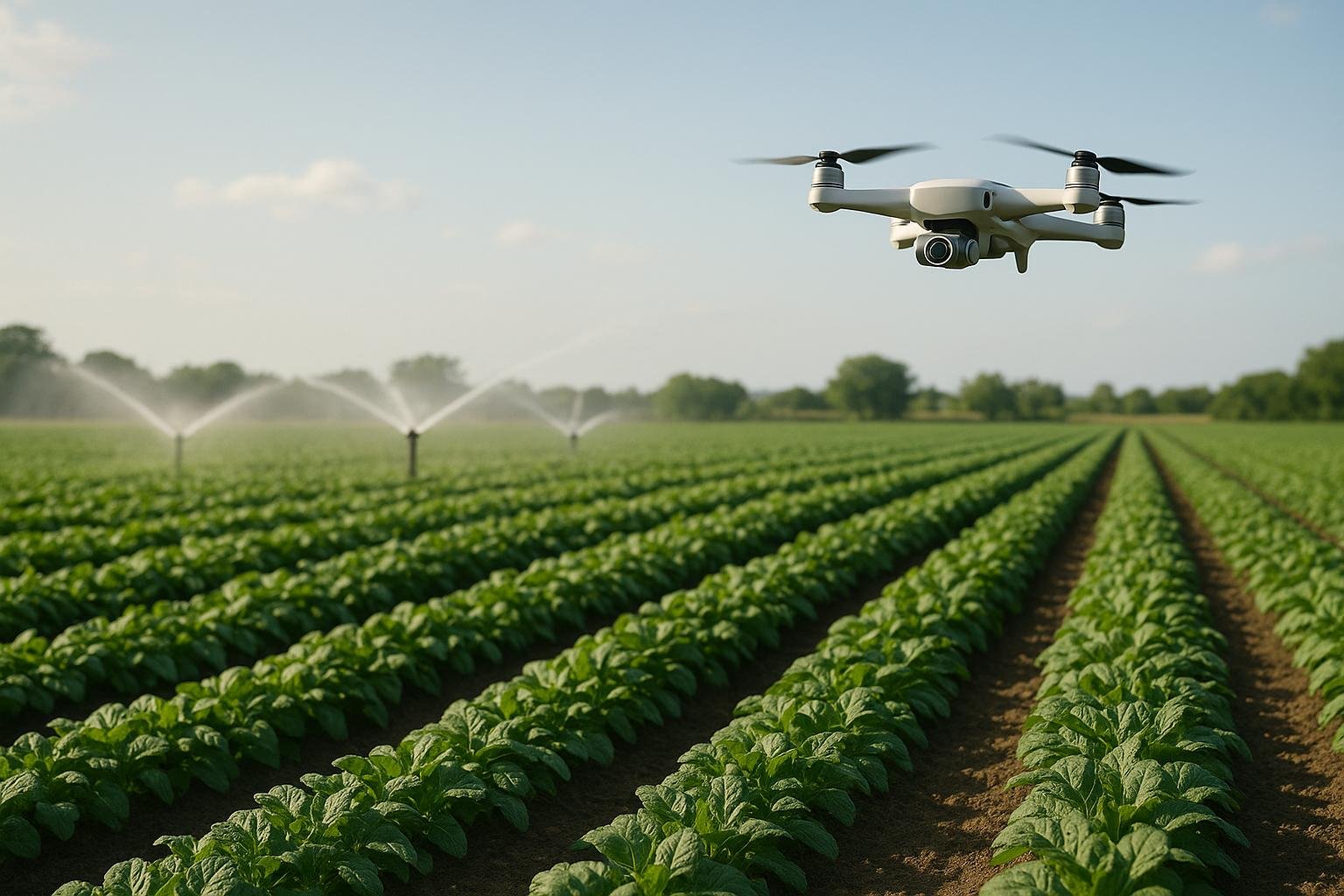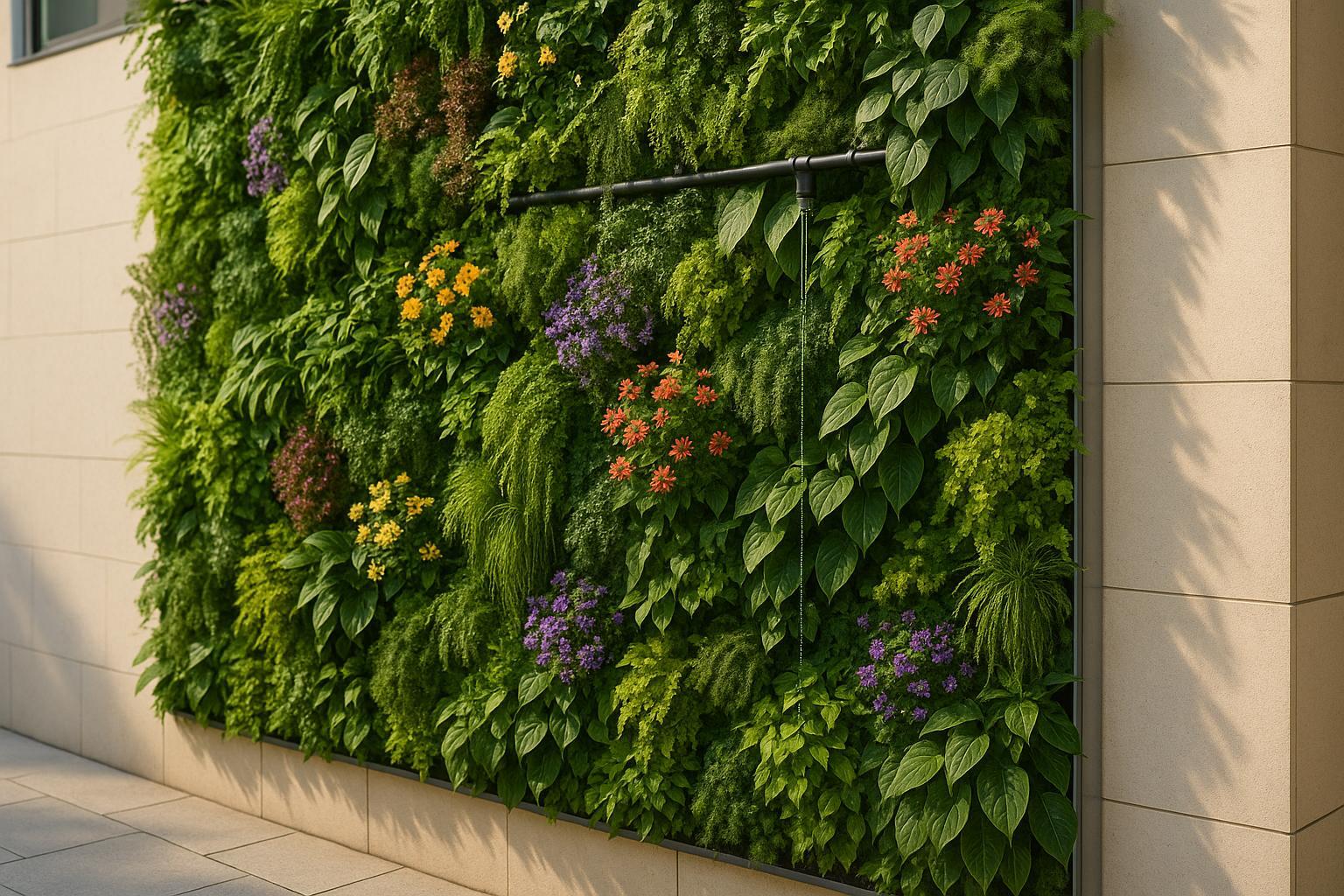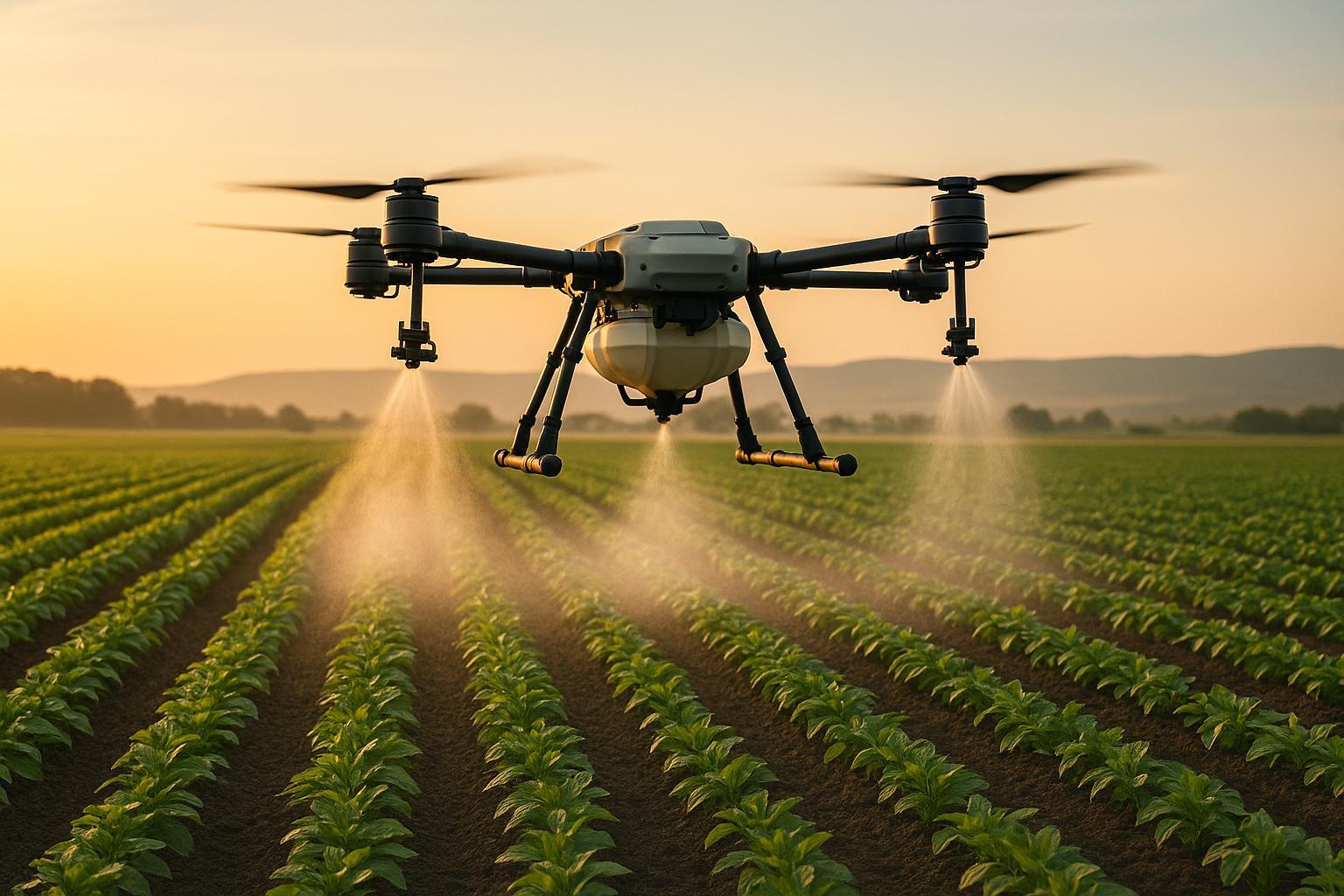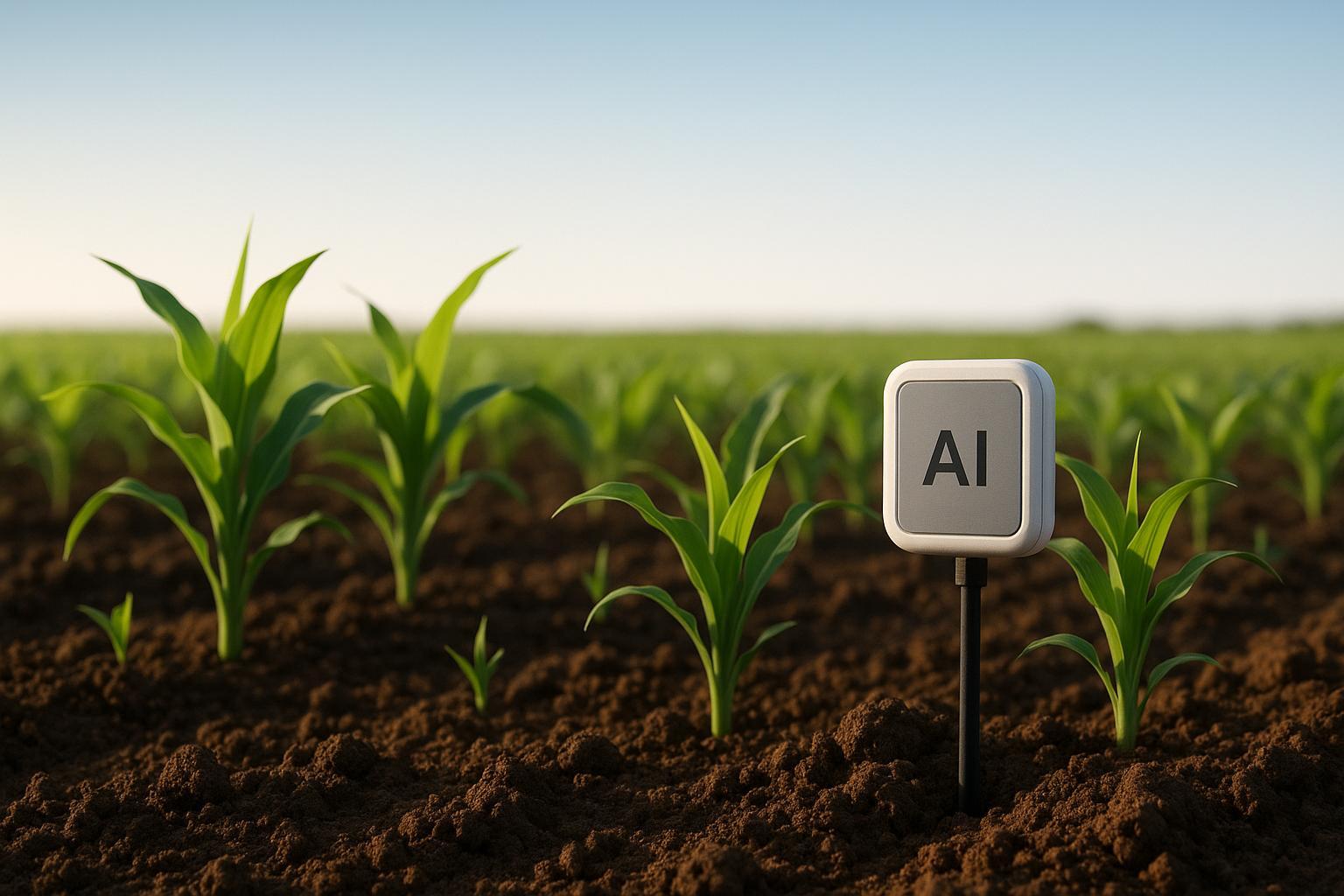How AI Detects Irrigation System Faults

AI-powered irrigation systems are changing how we manage water, saving up to 50% in usage while increasing crop yields by 20–30%. These systems use sensors, machine learning, and real-time monitoring to detect issues like leaks, clogged sprinklers, or faulty sensors before they become costly problems. Here's what they do:
- Monitor soil moisture, weather, and equipment performance using smart sensors and IoT devices.
- Analyze data with AI models to identify anomalies like leaks, pressure drops, or sensor malfunctions.
- Provide actionable insights through user-friendly dashboards and mobile apps.
- Automate responses like shutting off water during leaks or adjusting schedules based on weather.
AI irrigation systems are more efficient, accurate, and cost-effective than manual or outdated methods. They reduce water waste, improve plant health, and cut operational costs, making them a smart choice for homeowners, farmers, and landscapers alike.
Keep reading to learn how these systems work, common faults they detect, and how to set one up for your property.
Application of AI in Leakage Management in Water Distribution Networks

How AI Tools Monitor Irrigation Systems
AI-powered irrigation systems rely on a network of interconnected devices that gather, transmit, and analyze data in real time. This setup helps spot issues early, preventing costly breakdowns that could harm crops or landscapes.
Sensors and IoT Devices
At the heart of these systems are smart sensors and IoT devices that constantly collect environmental and operational data. These devices act as the system's eyes and ears, monitoring soil conditions, water flow, and equipment performance.
For instance, soil moisture sensors, temperature monitors, and pH sensors provide the raw data needed for AI analysis. Water flow meters detect pressure changes or volume drops, signaling potential leaks or blockages. Other sensors track environmental factors, ensuring conditions remain ideal for plant growth.
"IoT (Internet of Things) smart irrigation integrates Internet-connected devices and sensors into traditional systems. The integration creates more efficient, automated residential, agricultural, and commercial solutions." - Irrigreen [6]
This growing use of sensor networks underscores their importance in modern irrigation. Wireless sensor networks now monitor multiple factors simultaneously, such as soil moisture, weather, water quality, and even plant health metrics like leaf wetness and transpiration rates. By 2020, around 800,000 sensor systems and remote-control units were already in use for crop and irrigation management across the U.S. [5].
In remote areas with limited access to power, battery-free and solar-powered sensors are becoming more common, offering a practical solution for continuous monitoring.
Data Collection and Transmission
Once data is collected, it needs to be transmitted efficiently to AI systems for processing. This is where the network layer comes into play, ensuring secure and reliable communication between sensors and cloud platforms.
Wireless transmission protocols are key to this process. While WiFi provides high-speed connectivity, it falls short in range and power efficiency for outdoor environments. Alternatives like LoRa (Long Range) networks are better suited for large-scale agricultural settings, offering extended range and low power consumption [4].
For remote and energy-efficient operations, protocols like LoRa and ZigBee are ideal [4]. They provide strong coverage over wide areas while minimizing battery drain, which helps sensors last longer.
The transmitted data includes critical environmental parameters - soil moisture, temperature, humidity - as well as equipment metrics like water flow rates, pressure, and quality indicators such as pH and conductivity. Plant health data, such as growth measurements and leaf wetness, is also sent to AI systems in real time.
To ensure seamless operation in remote locations, advanced systems often combine on-site and cloud-based processing. Immediate decisions, like shutting off water in case of a leak, are handled locally, while more complex analyses and long-term trends are processed in the cloud.
Once the AI processes the data, the results are presented to users through intuitive interfaces.
User Interfaces for Diagnostics
After sensors gather the data and AI systems analyze it, the information is delivered to users through intuitive dashboards and mobile apps. These platforms simplify complex data, turning it into actionable insights that users can easily understand and act upon.
Modern dashboards provide real-time updates on soil moisture, water usage, and plant health. Users can access detailed system information, including current sensor readings, historical trends, and predictions for future irrigation needs.
Mobile apps offer full remote control, enabling users to monitor and adjust their systems from anywhere [7]. These apps provide instant updates on water usage, pressure, and equipment status, making it easy to respond to issues as they arise.
Some interfaces include mapping tools that display sensor locations and historical data across a property [8]. Clicking on a sensor marker reveals real-time readings and graphs showing changes in parameters like temperature or soil moisture over time.
But these platforms go beyond just displaying data. AI-powered systems can provide real-time diagnostics and step-by-step troubleshooting guides [7]. If an anomaly is detected, users receive alerts and recommendations directly on their smartphones.
Advanced platforms even integrate with tools like OpenAI to create automated reports tailored to specific site conditions [8]. These reports combine historical and real-time data into easy-to-understand visuals, helping users assess system performance and identify potential issues.
For added convenience, AI chatbots and virtual assistants are available to answer questions, guide users through setup, and provide maintenance tips [7]. These assistants make navigation easier by offering personalized suggestions based on user habits.
With these tools, users gain complete transparency over their irrigation systems. They can make quick adjustments based on crop needs or weather changes, visualize areas under water stress, and receive personalized irrigation recommendations through interactive maps. This level of control ensures efficient water management and healthier plants [8].
Common Irrigation System Faults AI Can Detect
AI-powered irrigation systems go beyond real-time monitoring by pinpointing specific system faults with impressive accuracy. These systems analyze data continuously, catching potential problems early before they escalate into major issues. By doing so, they help conserve water, protect plant health, and shift irrigation management from a reactive approach to a proactive one. Here are some common faults AI can identify and address effectively.
Leaks and Pipe Bursts
Water leaks are not just wasteful - they're expensive. A single undetected leak can waste nearly 6,300 gallons of water every month [11]. AI systems monitor water pressure and flow, comparing them to historical data to identify irregularities. For instance, sudden pressure drops or unexpected surges can signal leaks or pipe bursts. When these anomalies are detected, AI can even trigger automatic shutoffs to limit damage.
A great example of this is Singapore's Smart Water Grid, which uses AI to detect pipe bursts and reduce water losses significantly [10]. Similarly, IBM's AI water management solutions help cities manage water demand and prevent shortages by catching leaks early [10]. For underground leaks, which are often invisible, AI can identify subtle pressure changes, enabling precise repairs without unnecessary excavation.
Clogged Emitters or Sprinklers
Clogged irrigation components disrupt water distribution, causing stress to plants and wasting resources. AI systems identify these blockages by analyzing pressure and flow data, comparing them to expected patterns, and cross-referencing with plant stress indicators. For example, a blockage typically causes upstream pressure to rise while downstream flow decreases - patterns that AI algorithms can detect.
Clogging in systems like drip irrigation can result from physical debris, chemical deposits, or biological growth [12]. Knowing the type of clog is crucial for choosing the right maintenance solution [12]. With AI, these issues are identified early, ensuring efficient water distribution and reduced waste.
Sensor Malfunctions and Calibration Issues
Faulty sensors can throw an entire irrigation system off balance, leading to overwatering, underwatering, or missed irrigation cycles. AI addresses this by cross-checking data from multiple sensors and historical records to flag unusual readings. For instance, if a soil moisture sensor reports values that differ significantly from nearby sensors in similar conditions, the system identifies it as a potential calibration issue or failure.
AI systems also compensate for faulty sensors by using redundancy and correlation analysis. If one sensor malfunctions, the system can rely on weather data, evapotranspiration models, and nearby sensors to maintain accurate irrigation schedules. Drift detection is another key feature, as sensors can lose accuracy over time due to environmental exposure or aging. AI tracks these gradual changes, adjusts irrigation schedules accordingly, and alerts users when maintenance or replacement is needed.
Xylem Inc. showcases this capability by employing AI to detect water contamination in urban water networks [10]. Additionally, integrating satellite imagery and drone data can further validate ground-based sensor readings [9]. When discrepancies arise between sensor data and aerial observations of plant health or soil conditions, AI can quickly identify faulty sensors. These fault-detection capabilities form the foundation for the advanced AI techniques discussed in the following sections.
sbb-itb-4d6a8dd
🚀 Ready to Reinvent Your Garden?
Join thousands of homeowners who have transformed their gardens using our AI design tool. Upload one photo to explore endless possibilities.
Get your AI garden designs →AI Methods for Fault Detection
Using sensor monitoring and advanced data analysis, AI methods identify faults with impressive accuracy. AI-powered irrigation systems rely on sophisticated algorithms to turn sensor readings into actionable insights, continuously analyzing patterns to detect problems before they escalate into costly failures. Compared to older, traditional methods, these techniques are far more effective and efficient.
Machine Learning Models for Anomaly Detection
Machine learning models are particularly skilled at identifying unusual patterns by first establishing what “normal” looks like. Two standout approaches in this area are autoencoders and Generative Adversarial Networks (GANs), both of which work exceptionally well with time-series data generated by irrigation systems.
Autoencoders compress and then reconstruct irrigation data. When there’s a significant reconstruction error - possibly due to a sudden pressure drop or an unusual flow pattern - it signals an anomaly. For example, the PRIMA INTEL-IRRIS project uses this method to detect faults in smallholder farming communities, making advanced irrigation technology more accessible.
GANs, on the other hand, employ a generator to learn normal patterns and a discriminator to flag deviations. This setup captures complex anomalies that simpler models might overlook.
In controlled experiments, autoencoders demonstrated high accuracy rates: 90% for soil moisture anomalies, 95% for air temperature issues, and 97% for detecting irregularities in air humidity. Techniques like data normalization and sliding windows further boost their performance.
Real-Time Signal Processing
Real-time signal processing plays a critical role by analyzing sensor data as it streams in. This approach cleans, filters, and interprets signals from pumps, valves, and other equipment to detect issues instantly.
The process starts with low-pass filters that remove noise and interference from sensor readings. For instance, power consumption data from irrigation actuators is adjusted for scale and offset, resulting in clean, reliable signals. By comparing control commands with actual power usage patterns, the system can quickly identify abnormalities or malfunctions.
A notable example comes from a 2025 study at Chungnam National University in South Korea. Researchers developed a signal processing system for automated orchard irrigation, monitoring apple trees using commercial current sensors. A Python-programmed microcontroller managed pumps and solenoid valves, cycling them every 60 seconds while transmitting data to a smartphone app. The system achieved remarkable precision: 99.9% accuracy for detecting pump and solenoid valve issues and 99.7% for secondary valve malfunctions.
By combining real-time signal processing with machine learning techniques, these methods enhance overall system performance.
Benefits of AI Methods
AI-driven fault detection offers far more than just identifying problems - it delivers measurable improvements in efficiency, cost savings, and operational reliability. Here’s how AI-powered methods stack up against traditional approaches:
| Benefit Category | Traditional Methods | AI-Powered Methods | Improvement |
|---|---|---|---|
| Water Efficiency | Fixed schedules | Real-time, predictive control | 25–50% water savings [1][13] |
| Crop Productivity | Reactive management | Proactive, precise water delivery | 20–30% yield increases [1][9] |
| Energy Consumption | Inefficient pumping systems | Optimized pressure, smart scheduling | 50%+ reduction in energy use [13] |
| Fault Detection | Manual inspections | Continuous monitoring, predictive maintenance | 99%+ accuracy in anomaly detection |
| Operational Costs | High water waste, frequent repairs | Reduced waste, planned maintenance | Significant cost reductions |
These improvements translate into less water waste, fewer emergency repairs, and better resource management overall.
Meta-analyses show that AI-driven irrigation systems can save 30–50% more water and boost crop productivity by 20–30% compared to traditional methods [1]. For example, AI-optimized irrigation controllers have reduced water use by over 40%, while AI-driven low-pressure drip emitters have cut pumping energy by more than 50% [13].
Real-world applications back up these findings. California vineyards using AI-based irrigation cut water usage by 35% while maintaining crop quality. Dutch greenhouses saw a 20% increase in yields through real-time irrigation adjustments. Meanwhile, Australian farms reduced irrigation by 25% and improved crop uniformity by using satellite AI to identify water-stressed areas [2].
But AI doesn’t stop at detection. These systems can automatically shut off water during leaks, adjust watering schedules based on weather forecasts, and notify maintenance teams with specific diagnostics. This proactive approach transforms irrigation into a highly efficient, resource-saving operation.
"AI leverages data from various sources - such as weather forecasts, soil moisture sensors, and satellite imagery - to make intelligent irrigation decisions. By continuously analyzing data, AI-driven irrigation systems ensure precise water distribution and efficient resource management." - Ted Wodoslawsky, c3controls [2]
Steps to Set Up AI-Based Irrigation Monitoring
Creating an AI-driven irrigation monitoring system involves careful planning and execution. The process can be broken down into three main steps: setting up the hardware and sensors, configuring AI models to process your data, and fine-tuning the system to align with your specific environmental and crop needs.
Installing Hardware and Sensors
The backbone of any AI irrigation system is its hardware. Start with soil moisture sensors, which measure water content in the soil. These sensors typically cost between $99 and $165 and should be placed in key areas of your irrigation zones, avoiding spots like sprinkler heads, tree roots, or structures that might skew the readings [14].
Weather monitoring tools are just as important. Rain sensors, which prevent irrigation during rainfall, range from $30 to $50 for wired models and $120 to $200 for wireless versions. These should be installed in open areas without obstructions [14]. Similarly, wind sensors, costing around $80 to $100, help avoid irrigation during high-wind conditions. At the system's core is the central controller, which manages sensor data and irrigation schedules. For instance, ET controllers, which use weather data to calculate evapotranspiration, range from $250 to $900 for basic models, with high-end options priced up to $2,500. Soil moisture controllers, another option, are priced between $280 and $1,800 [14].
Wireless sensors and gateways should be strategically placed to ensure a strong, reliable signal. Regular maintenance is also critical - clean sensors frequently and remove debris to maintain accuracy [15]. Calibration is equally important; soil moisture sensors should be calibrated either on-site or in a lab using a dry-down curve to ensure precise measurements [16].
| Hardware Component | Price Range | Key Function |
|---|---|---|
| Soil Moisture Sensors | $99 - $165 | Measures soil water content |
| Rain Sensors (Wireless) | $120 - $200 | Stops irrigation during rainfall |
| Rain Sensors (Wired) | $30 - $50 | Stops irrigation during rainfall |
| Wind Sensors | $80 - $100 | Prevents irrigation in high winds |
| ET Controllers | $250 - $2,500 | Weather-based irrigation control |
| Soil Moisture Controllers | $280 - $1,800 | Soil-based irrigation control |
Once your hardware is installed and calibrated, the next step is to configure AI models to make sense of the data.
Setting Up AI Models and Data
With the hardware in place, the focus shifts to processing the collected data and turning it into actionable insights.
Data Collection and Integration
Integrate data from soil moisture sensors, weather stations, and even satellite imagery. Historical trends play a key role here, helping train machine learning models - such as regression models, neural networks, or support vector machines - so they can recognize normal patterns and spot anomalies. Calibrate these models with precise soil measurements, and use drift-detection techniques to account for sensor changes over time.
Model Training and Calibration
Historical data is essential for training AI models. By calibrating these models with accurate soil moisture readings, you can fine-tune them to reflect your crops' unique needs and soil properties [16]. Techniques like Explainable Artificial Intelligence (XAI) can also make these models easier to interpret, which is especially important when making decisions that directly impact agricultural yields [1].
Tailoring these models to local conditions ensures maximum efficiency in water usage and crop health.
Adjusting to Local Conditions
Fine-tuning your AI system to match local conditions is a must, especially given the diverse climates and soil types across the United States.
Climate Zone Considerations
Regional climate differences - such as rainfall patterns, evapotranspiration rates, and temperature fluctuations - should guide how your AI models operate. For example, a system designed for Arizona’s dry climate will differ significantly from one optimized for Florida’s humid conditions. A vineyard in California, for instance, implemented an AI irrigation system that reduced water usage by 35% while maintaining crop quality, even during drought conditions [2]. Similarly, a farm in Australia used satellite AI to pinpoint water-stressed areas, cutting irrigation by 25% and improving crop uniformity [2].
Soil Type and Crop Customization
Soil properties play a major role in irrigation. Clay soils retain water longer than sandy soils, which means irrigation schedules will vary. Crops also have unique water needs depending on their type and growth stage. For instance, fruit trees, vegetables, and row crops all require different amounts of water at different times. Adjusting your system to account for these differences ensures better results.
Ongoing Monitoring and Maintenance
Consistent monitoring is essential to keep the system running smoothly. Regularly inspect hardware, sensors, controllers, and irrigation components to ensure they’re functioning correctly. Accurate data is the lifeblood of an AI system, so maintaining sensor reliability is critical.
Additionally, training users - such as farmers and irrigation managers - is just as important. They need to understand how to interpret the system’s outputs and respond to alerts effectively. While automation handles much of the work, human oversight remains a key part of the process.
"Smart irrigation systems use weather data and soil moisture sensors to optimize watering schedules, significantly reducing water waste." - Conserva Irrigation [15]
Conclusion
AI-driven fault detection is reshaping water management, making it smarter and more efficient. By fine-tuning water usage, these systems help conserve resources, increase crop yields, and cut down on repair costs while minimizing environmental harm. The results? Tangible improvements you can measure.
For instance, these systems can slash water usage by 30–50% while increasing crop productivity by 20–30% [1]. And this isn't just theory - real-world applications have shown consistent success across various agricultural settings [18].
The financial benefits are equally impressive. Take the Granite Park office complex in Dallas, Texas, as an example. By using a weather-based irrigation controller, they saved $47,000 in just one year, with a simple payback period of only 1.5 years [17]. On top of that, early leak detection and anomaly monitoring can prevent expensive emergency repairs.
The environmental perks are hard to ignore, too. These systems reduce chemical usage by targeting applications more precisely, cut contamination risks, lower carbon emissions, and boost energy efficiency [1]. And it's not just about big industries - homeowners are getting in on the action as well. AI tools empower garden enthusiasts to manage their spaces more effectively, making professional-grade technology accessible on a personal level.
For example, platforms like AIGardenPlanner bring cutting-edge AI to home gardening. Features like the AI Plant Advisor offer tailored plant recommendations based on your location, climate, and soil conditions, making advanced irrigation tools available for everyday gardeners.
Looking ahead, the future of irrigation lies in intelligent, adaptive systems that respond to real-time changes. Tim Thomure, former Director of the Tucson Water Department, highlights this shift:
"With VODA.ai's daVinci machine learning technology, we will be able to make smart decisions, save valuable resources, and protect our water infrastructure." [3]
This technology marks a shift from reactive maintenance to proactive management, delivering benefits for both users and the environment. It’s a forward-thinking approach that’s setting the stage for smarter, more sustainable irrigation solutions.
FAQs
How do AI-powered irrigation systems save water and boost crop production?
AI-powered irrigation systems are transforming water management by using real-time data - like soil moisture, weather forecasts, and specific plant requirements - to deliver the exact amount of water needed. This precision can cut water usage by an impressive 20-50%.
Beyond saving water, these systems ensure plants receive optimal hydration, which encourages healthier growth and can boost crop yields by 20-30%. This data-driven method not only helps conserve resources but also enhances farm productivity, making it a win-win for both farmers and the environment.
What sensors and IoT devices are used in AI-powered irrigation systems, and how do they help detect issues?
AI-powered irrigation systems use a network of sensors and IoT devices to monitor and fine-tune their performance. Some of the most common tools include soil moisture sensors, temperature and humidity sensors, weather sensors, flow sensors, and environmental sensors. These devices gather real-time data about soil conditions, weather changes, and water flow.
With this information, AI algorithms can swiftly detect problems such as leaks, clogged pipes, or malfunctioning sensors. This ensures the system runs smoothly, saves water, and maintains efficiency without constant manual oversight.
How does AI adapt irrigation systems to different climates and soil types?
AI transforms irrigation systems by using data from sources like soil moisture levels, soil composition, pH, and local weather forecasts. With this information, it develops precise watering schedules and fine-tunes water usage to match specific conditions.
By forecasting droughts and extreme weather, AI ensures water is used wisely, supporting healthy soil and plant growth. These systems adapt in real-time to varying climates and soil types, making irrigation more efficient and environmentally conscious.
🎨 Visualize Your Dream Garden Today!
Transform any outdoor space into a professional landscape design in minutes. Just upload a photo, choose your style, and let our AI do the rest.
Start your garden transformation now →Related posts
Related Articles

How AI Improves Soil Moisture Data Analysis
Explore how AI enhances soil moisture analysis, optimizes irrigation, and promotes healthier plants while conserving water in agriculture.

AI Scheduling for Vertical Gardens
Explore how AI scheduling enhances vertical gardening by optimizing irrigation, improving plant health, and conserving resources.

Precision Spraying: AI Drift Reduction Tips
Explore how AI technology enhances precision spraying in agriculture, reducing pesticide drift and improving efficiency for sustainable farming.

Ultimate Guide to Low-Carbon Garden Materials
Learn how to choose low-carbon materials for your garden to enhance sustainability, support local ecosystems, and reduce emissions.

Maximizing Small Spaces with Raised Garden Beds
Learn how to start a garden in limited space with raised garden beds. Discover the benefits of raised garden beds and important factors to consider when choosing and building them.

AI for Soil Water Retention Analysis
Explore how AI is revolutionizing soil water retention analysis, optimizing irrigation, and aiding in drought-resistant plant selection for sustainable gardening.